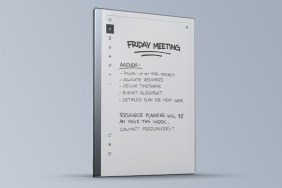An eternal flame.
One of the differences between last year’s Burnout: Revenge and this year’s 360 release is right there on the cover. In the upper right-hand corner, a neat graphic lets the consumer know that Burnout: Revenge won “Best Driving Game” of the year from Spike TV.
“Funny,” I thought, as I cruised down the virtual boulevard at a modest 210 miles per hour, “as Burnout‘s billboards advertise Spike TV.” Conspiracy? Hardly, just another nod-and-wink, cash-drenched handshake opportunity that GR got shut out of. It’s not that we oppose backroom deals, per se, but more that we rarely get invited into the backroom at all. I hear there’s strippers in there!
[image1]But despite such shady advertising schemes, last year’s game actually did deserve its praise, and this 360 port simply polishes the chrome and tricks out the online game. While not screwing with the formula, tracks, or gameplay, this next-gen Burnout is still the same game, but obviously better for wear. So in the spirit of retouching and reselling, the following review is mostly the same as last year’s. We’re getting good at this.
First, the new stuff. In the 360 version, EA seems to have sanded down some of the rougher edges. There are still hordes of ways to wreck your vehicle, but better collision mapping means that now they don’t include invisible furniture on the edge of the road.
The big changes, however, are found in the online game. New for the 360 is the inclusion of Road Rage events, which had always been a multiplayer favorite in the prior two Burnouts, but is only available online in the 360 version. In Road Rage, you and your human opponents battle against each other and a slew of computer rivals. It’s like a vehicular Deathmatch and it’s good fun.
The power of the 360’s online setup comes into play with tracked “Rivals.” The 360 keeps track of everyone you’ve taken out and everyone who has taken you out. The more you play, the more rivals you accumulate. While it doesn’t change the gameplay much, it does add satisfaction to your kills and helps build a sense a personality to your otherwise anonymous opponents.
And after you’re done smashing them, you can send them clips of your favorite crashes or races. Last year, we complained about the lack of a replay function. EA did us one better by including not only a replay function for every race, but the ability to record whatever spectacular snippets of that replay we choose. Then, you can send the clips to friends, and with luck, perhaps, find yourself listed on the “most downloaded” section of the online menu.
[image2]Despite all of these little innovations, if you buy a 360 game, you want to see it perform graphically. The original Burnout: Revenge was one of the prettiest racing games ever released, but the 360 version is a fraction prettier. The cars and tracks are retouched with that magic wand of the next-gen gleam, and the framerate holds steady in even the most processor-crunching crashes. However, there isn’t much that is new about the graphics—they were good before, and now they’re a little better.
Really the most noticeable revision is in the damage modeling. Every car chips and tears its paint as it scrapes through traffic and siderails. It’s certainly more detailed, but it leaves most of the cars looking like sheet metal as each of the cars is silver beneath the paint.
Which is a fitting analogy for the 360 version of Burnout. Featuring a slightly slicker surface, this game is made of the same metal as its current-gen counterparts, which themselves were largely recycled from Burnout: Takedown. There were two major additions to Revenge that changed the tone and action of the game significantly, and those are still intact.
The first is the ability to “traffic check” same-way traffic. By hitting cars, vans, and pickup trucks from behind, you can launch them into the air and across the track. Besides building boost, the careening wreckage becomes a useful weapon. Sail a Civic into your enemy and he’s out like a Pinto with no brake lights.
Whether or not this small but significant change is for the better depends largely on the kind of gamer you are. Arcadey as it was, Takedown emphasized dodging and precise navigation. Revenge, however, rewards smashmouth driving. Hurtling vehicles at your enemies feels a bit like dropping banana peels from a Mario Kart. While the “traffic checks” certainly amplify the battling aspect of Burnout, they also reduce the attention to driving and racing. Why weave through traffic when you can burrow through it instead?
The other significant addition is the re-mapping of the tracks to include hundreds of alternate paths. No longer are you confined to a single route, as you can steer your vehicle through parking garages, over impromptu ramps, into warehouse districts, over the hill, through the wood, and even by your proverbial grandmother’s house. Indeed, there are so many alternate routes that it is often difficult to know which, if any, is the intended route. Some alternates are shortcuts, others launch you off breathtaking ramps, and a few just land you in a maze of obstacles.
[image3]While the introduction of a breathtaking vertical game is a no-brainer (catching air also subjects you to wind conditions and thrilling screen blurring), the mayhem of the tracks can leave you without a brain. You never really feel in control when flying down the tracks, under buildings, and through aqueducts. As the game progresses, you begin to learn where the useful shortcuts are, but the awesome speed of the game can be a bit frustrating when you keep missing exits, or worse, totaling your car into the face of a brick wall next to an exit. Probably as many people will like the alternate routes as those who will hate them; I was a bit dismayed that the racing and precision were sacrificed for nearly out of control driving and more than a few quarts of chance.
Additionally, the specs for the available cars are still limited to just weight and speed. For my money, I want to know the difference between the Limited M-type that goes 180 mph and the M-type DX that also goes 180 mph. It does seem that the cars have distinct personalities, but the game should just tell you that one handles better or accelerates better as it would make the choice between cars something more than a cosmetic afterthought.
As nice as it is on the eyes, Revenge is, like its predecessor, hard on the ears. EA has really warmed up to the pop-punk scene, and the result is that many of their best games are saddled with similarly whiny, overly self-important, vanilla rock. This is a perfect time to try out the 360’s personal music option.
“Crashbreakers,” one of last year’s innovations, are here as well. When you wreck, not only can you nudge your flaming carcass into the path of your opponents, but you can explode it with the touch of a button. The size of your explosion is governed by the amount of boost you had upon wrecking, making it a bit risky, but can be well worth it if you nail a rival to keep him from taking the lead. Here’s to unnecessary pyromania!
And here’s to a successful port. Burnout: Revenge for the 360 is basically the same experience as last year’s Burnout: Revenge with some streamlining in both the graphics and online features. Some purists may still be turned off by the confusing tracks and the “traffic-check” carnage, and there probably isn’t enough new here to warrant a buy for those who have already played through Revenge last year, but the engine is running more smoothly than ever, adding another solid racer to the growing 360 garage.
-
Same Takedown formula
-
Next-gen graphics
-
Replay and record
-
Online rivals and Road rage
-
Traffic checking
-
Nothing new to the gameplay
-
Still no car specs










